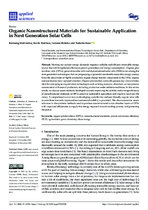Organic nanostructured materials for sustainable application in next generation solar cells

View/
Date
2021Author
Mabindisa, Rorisang
Tambwe, Kevin
Mciteka, Lulama
Metadata
Show full item recordAbstract
Meeting our current energy demands requires a reliable and efficient renewable energy
source that will bring balance between power generation and energy consumption. Organic photovoltaic cells (OPVs), perovskite solar cells and dye-sensitized solar cells (DSSCs) are among the
next-generation technologies that are progressing as potential sustainable renewable energy sources.
Since the discoveries of highly conductive organic charge-transfer compounds in the 1950s, organic
semiconductors have captured attention. Organic photovoltaic solar cells possess key characteristics
ideal for emerging next-generation technologies such as being nontoxic, abundant, an inexpensive
nanomaterial with ease of production, including production under ambient conditions. In this review
article, we discuss recent methods developed towards improving the stability and average efficiency
of nanostructured materials in OPVs aimed at sustainable agriculture and improve land-use efficiency. A comprehensive overview on developing cost-effective and user-friendly organic solar cells
to contribute towards improved environmental stability is provided. We also summarize recent
advances in the synthetic methods used to produce nanostructured active absorber layers of OPVs
with improved efficiencies to supply the energy required towards ending poverty and protecting
the planet
